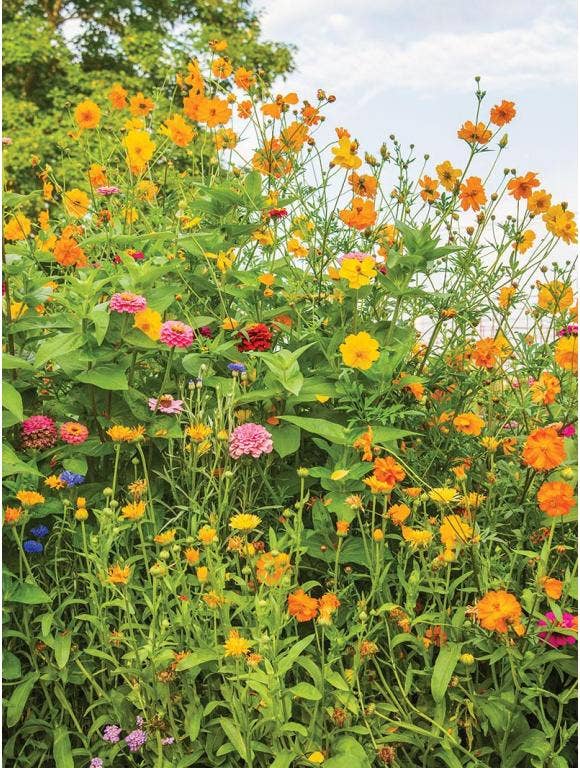


Just like a bouquet of flowers can say "special occasion," learning how to plant flowers at your apartment, townhome, condominium or house can make the whole season feel like a celebration. With a flower garden, you can enjoy a daily splash of color and nonstop bouquets.
If you're ready to dip your toes into flower gardening for beginners, you can start simple with a patio planter or a small decorative garden by a walkway or mailbox. With time, it won't be difficult to create a bigger cottage garden with several kinds of flowers that can keep it buzzing with bees, butterflies and hummingbirds.
Finding Dependable Sunlight
The first consideration for a flower garden is location. Do you have a spot that gets six to eight hours of sunlight a day? It takes steady solar energy to keep most plants healthy. If you don't have that much sun, you'll need to consider flowers that thrive in the shade, such as impatiens or hostas.
Providing Good Soil
If you're using planters, make sure you fill them with good quality potting soil, which is designed to retain essential moisture and encourage the spread of roots.
If you're looking at a garden or larger landscaping project, evaluate your soil first. Make sure it's not too sandy (and quick to dry out) and not too sticky with clay (which can trap water and rot roots).
You can improve your soil by adding organic matter to make it drain better while also holding in moisture if needed. Additionally, test the pH and fertility of your soil with an electronic soil tester and learn when and how to amend soil.
Deciding Between Annuals and Perennials
Flower gardening for beginners may be a little daunting with hundreds of colorful temptations in a gardening catalog or gardening center. Start by narrowing down those choices. Do you want annuals, perennials or a mix of both?
Annuals need to be replanted each year and will typically bloom all season. Mix and match annuals with contrasting or complementary colors for attractive window boxes, patio planters and hanging baskets.
Perennials usually bloom for two to three weeks during the growing season. They go dormant over the winter and will grow back each spring, which makes them a great investment for larger gardens or landscaping areas you don't want to replant each year.
Start Annuals From Seed
If you want the joy of watching your plants grow from seeds, start with easy annuals. You can plant them directly in your garden following instructions on your seed packet. If you want to extend the time you'll see your flowers bloom, plant seeds indoors six to eight weeks before your last frost. Then, transplant them outside. You can also buy annuals as seedlings to shorten the time until they'll bloom.
Here are a few of the easiest full-sun varieties for beginner gardeners:
Choose Seedlings for Perennials
If you want perennials that will bloom for years, the best option is to buy garden-ready plants or seedlings that have been given a head start in professional greenhouses. These seedlings shouldn't be in bloom yet but rather on the cusp of it. You want them to do their blooming in your garden, not in the greenhouse.
Here are some solid favorites for adding texture and color to your garden or landscaping:
Mix and Match Your Garden
Many gardeners choose a combination of both perennials and annuals. Perennials can anchor key areas of your garden with larger standouts, such as peonies, clusters of irises and daylilies. Fill garden borders with easy-growing annuals such as petunias, marigolds or zinnias. Plant taller annuals such as cleome, sunflowers and cosmos among the larger perennials.
Planting in Containers
In northern climates, use only annuals in containers. You can plant them in the spring and enjoy them until frost comes in the fall. The living roots of a potted perennial will have difficulty surviving through a cold winter without ample protection.
However, in climates where winter cold isn't an issue, some perennials may live in pots for years. In warm climates, you can combine flowering annuals with perennials or foliage in a pot if they have compatible needs.
Taking Care of Flowers
To keep flowers blooming all season, water them with at least 1 inch of water weekly and use an all-purpose fertilizer, following instructions on the package. You may also need to deadhead — pinch off dried-up blooms — to encourage the plant to flower more. Particularly for perennials, deadheading allows the plant to divert energy from producing seeds into strengthening the plant. For perennials that require less maintenance, choose native plants that evolved in your area and thrived without any help from gardeners.
For more information on starting a flower garden for beginners, check out Burpee's garden guides to flowers.



